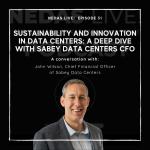 Originally posted on Data Center POST
Originally posted on Data Center POST
Byline: Steve Friedberg
Data Center World is one of the preeminent meetings for sector professionals during the year. As such, it‘s where these professionals gather and discuss emerging trends: what innovations are emerging to make data centers more efficient, what are end-users seeking from their vendors, and what do they believe the market will look like within 18-24 months?
In that context, Data Center POST posed these questions to a wide range of industry executives, including both vendors and analysts. To nobody’s surprise, Artificial Intelligence (AI) has significant mindshare. But, as you read through some of their comments, you’ll see that there’s far more on the table than just AI:
“I was at Google last week, and the first word that came out of Google’s mouth was AI. But it is going to be massive for the data center business, because what we’ve got with generative AI is what we had in 1994, with Netscape Navigator, that opened the internet up to commercialization,” says Roy Illsley, OMDIA’s chief analyst. “What generative AI, ChatGPT in particular, did was open up AI to be commercial. And now we’re beginning to understand the possibilities. But, in beginning to understand those possibilities, one of the things that we are understanding is when we’re training these models, we need some massive pieces of equipment. And air cooling is not going to cut the mustard, we’re going to have to go liquid cooling to cool these massive GPUs.”
Illsley sounds a note of caution, however, saying companies should not expect immediate returns on their AI investments: “People don’t understand what AI can do, so they’re just jumping on anything. That sounds good, but it’s not really a use case for AI. That’s because the board of directors of most companies have got no idea of what AI is, what the risks are. You’ve got to get the board trained, that they can mandate the governance and security to the CEO. And then the organization can use it. What we’ve got is a data scientist, engineer-led revolution, and it’s going to hit the buffers of legal. It’s going to hit the buffers of risk and reward and those are what’s going to slow things down. But the investment in the data center, they’ve got to do the skills and all the security, governance, risk management,” Illsley adds.
Richard Paul-Hus, SVP at Quantum Loophole, sees AI-driven hardware development as being a major innovation, and notes it’s already begun. “NVIDIA’s new Blackwell chip is a 30x improvement over what was the standard, and we’re expecting that next year. There’s going to be another giant leap, like a Moore’s Law doesn’t really apply in this space,” he says. “We’re seeing these massive advancements, and I think everybody’s lining up and trying to position themselves in this space. So there’s obviously a lot of interest in sorting for, you know, hundreds, if not gigawatts of capacity.”
Paul-Hus adds that edge data centers will represent what he calls a massive opportunity. “We are going to see the growth there tremendously. It really hasn’t evolved yet, to the degree that I thought it would have with rapid deployments. And then obviously, sorting out the energy truck to accommodate all of this sorting out the grid, modernization grid improvements, the introduction of various forms of storage into the grid. Those are all the big, big opportunities in the space right now.”
Bill Thomson at DC BLOX sees strong opportunities in vertical markets like financial services and higher education. “They have a need for a lot of research and a lot of different applications. And they’re very limited in their budgets and space,” he says, while noting that even smaller clients are demanding more space and a higher level of service. “There’s plenty of what I would call unserved demand for secure reliable data center space. We’re providing the same quality and reliable service in our data centers that you would get in any NFL city. When you’re in Birmingham or Chattanooga, or Greenville, you never had that before. So they are moving out of server closets. They’re moving out of their own strip mall data centers, if you will, that existed previously. There’s still demand for it.”
To continue reading the full article please click here.






